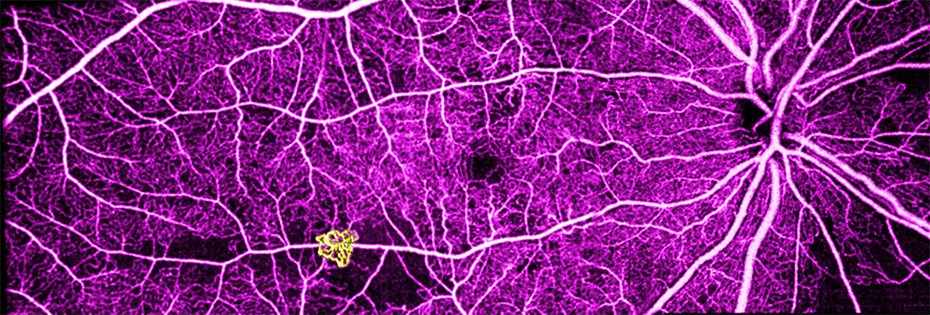
Leading advancement in OCT angiography
OHSU Casey Eye Institute is at the forefront of noninvasive imaging technology to detect vascular changes that may allow for treatment to prevent permanent vision loss from several eye diseases. Not only is OHSU Casey Eye Institute blazing a trail in how to use optical coherence tomographic angiography (OCTA) clinically, but we are also continually improving the capabilities of the technology.
A world-recognized leader in OCT structural and angiographic imaging, David Huang, M.D., Ph.D. runs the Center for Ophthalmic Optics and Lasers, or COOL Lab, at OHSU Casey Eye Institute. With his team, Huang is currently pioneering new applications of this extraordinary technology, including creating highspeed prototypes, novel signal and image processing, and piloting clinical studies utilizing OCTA in diagnosing and monitoring several critical eye diseases.
“OCT angiography is so relevant to eye health because all of the leading causes of blindness, including age-related macular degeneration, diabetic retinopathy and glaucoma, involve changes in retinal, choroidal and optic nerve circulation,” Huang said. “I believe OCT angiography will become just as important a tool as structural OCT. For example, conventional imaging techniques cannot detect choroidal neovascularization until it becomes exudative, turning AMD into the wet form. But with OCTA, we can detect these precursor lesions and potentially identify eyes that would benefit from prophylactic treatment.”
Huang and his team are also studying OCTA’s effectiveness in the early detection of neovascularization in diabetic retinopathy. The ability of OCTA to make a big clinical impact depends on further enhancing the efficiency and reliability of the imaging technology and algorithms, according to Huang. “There are a lot of nuances in getting a clean OCTA image,” Huang said. “Our lab is improving the technology’s ability to accurately determine capillary density in different layers of the retina using methods that can resolve the four retinal vascular plexuses. We have also developed ways to cancel out artifacts caused by signal strength variation and eye motion.”
Ongoing potential for other OCT innovations
The COOL Lab is also pursuing research in other novel OCT technologies and new clinical applications. These include the use of nanoparticles as OCT contrast agents, OCT elastography in measuring corneal mechanical properties, Doppler OCT to measure retinal blood flow, directional OCT to measure tissue composition, ray tracing on OCT images to calculate visual optics, and artificial intelligence to detect and classify corneal and retinal pathologies. Huang expects significant advances to continue for the foreseeable future. “OCTA is the new frontier in OCT research,” Huang said, “but it is not the last frontier.”
Unique climate for innovation
From Huang’s perspective, the COOL Lab at OHSU Casey Eye Institute is a leading international contributor to research and applications of OCTA because it bridges the technology to clinical use, supported by an institutional culture conducive for collaboration. “At OHSU Casey Eye Institute, we tailor engineering innovations to have maximal clinical impact,” Huang said. “This is a special environment where engineers, scientists and clinicians work closely together. Not all labs have those resources. We can go from basic technology development to translational research to directly relevant clinical studies. This degree of vertical integration is special in any discipline.”
Co-founder of transformative technology
As a Ph.D. student at Massachusetts Institute of Technology, Casey Eye Institute’s David Huang, M.D., Ph.D., was the co-inventor of optical coherence tomography (OCT) technology, the most commonly used ophthalmic diagnostic technology worldwide, with an estimated 30 million OCT imaging procedures performed every year. “OCT imaging succeeded beyond even what we anticipated in 1991,” Huang said. “I am pleased to see how the technology has evolved over the past 27 years. The No. 1 application now is for aged-related macular degeneration. OCT use continues to grow rapidly in ophthalmology and other medical specialties.”
COOL Lab
David Huang, M.D., Ph.D. runs the Center for Ophthalmic Optics and Lasers,, or COOL Lab, at OHSU Casey Eye Institute with a team of top scientists from around the world who have been perfecting OCTA technology and investigating multiple clinical applications. This team includes Yali Jia, Ph.D., who has received international recognition for several contributions to OCTA technology. The COOL Lab is supported by four NEI grants to develop OCTA technology for applications in age-related macular degeneration, diabetic retinopathy, glaucoma and anterior eye diseases.